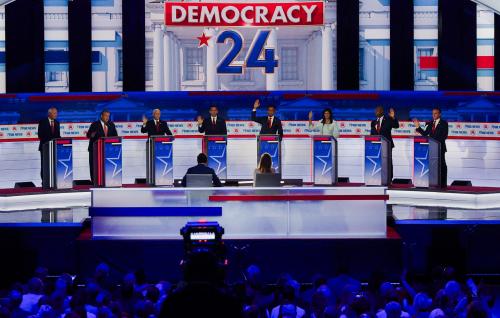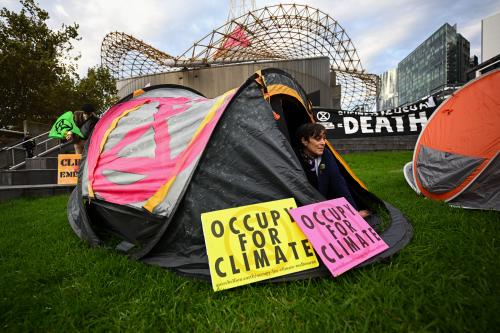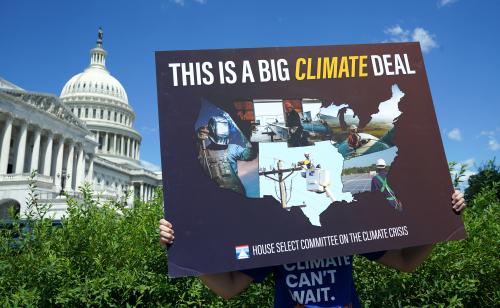Editor’s Note: As part of the 2014 Midterm Elections Series, experts across Brookings will weigh in on issues that are central to this year’s campaigns, how the candidates are engaging those topics, and what will shape policy for the next two years. In this post, Philip Wallach surveys how the EPA’s Clean Power Plan fares in retail politics.
Back in June, the Environmental Protection Agency proposed the Clean Power Plan, the centerpiece of the Obama administration’s strategy for combating global climate change which would force states to reduce their power sectors’ greenhouse gas emissions over the next 15 years. Over the summer I had a spirited exchange on Brookings’ PlanetPolicy blog with former EPA Senior Policy Counsel Bob Sussman about the merits and staying power of the proposal, and one of the key points of contention was just how politically sustainable the plan will be in coming years. I argued that a democratic legitimacy deficit—rooted in part on the widely varying reduction requirements that the plan imposes on different states, and in part on regionally-based hostility to action on climate change—is likely to detract from the plan’s effectiveness. The 2014 midterm elections provide the first opportunity to see how the Clean Power Plan fares in retail politics, and the initial signs confirm my earlier warnings. The Plan’s treatment on the campaign trail is bad news for its backers.
The basic picture is of progressive Democrats in safe seats pushing the need to act aggressively on climate change; moderate Democrats in contested seats often running away from the EPA rule as fast as they can; and Republicans presenting a nearly unified front of opposition against the EPA’s actions on climate change, often featuring denunciations of bureaucratic overreach. Such a configuration makes the Clean Power Plan’s future entirely dependent on progressive political fortunes—hardly a recipe for success for a policy that needs a decade and a half to develop and deliver its headline results.
First, the good news for the EPA and its allies: progressive candidates are enthusiastically supporting the Clean Power Plan and other executive branch-led efforts to combat global climate change. To support this message, Tom Steyer has spent a remarkable $58 million, mostly through his NextGen Climate Action Committee. Many Democrats see defending the EPA’s plan as a winning issue, believing that voters have begun to care more deeply about acting against climate change in recent years. Even Democrats locked into some competitive races are willing to tout their support for EPA, such as Mark Udall in Colorado and Bruce Braley in Iowa (though it should be noted that both states were unusually committed to developing renewable energy sources even before EPA’s rule).
Next, on to the more abundant bad news for the Clean Power Plan, beginning with Democrats who have pointedly distanced themselves from EPA’s proposal and in many cases promised to fight against it. Beginning with the Clean Power Plan’s initial release in June, many red-state Democrats have attacked it as a way to create distance between themselves and President Obama. A partial selection includes: Senate candidate Alison Lundergan Grimes of Kentucky, “strongly oppose President Obama’s attack on Kentucky’s energy industry”; Senate candidate Natalie Tennant of West Virginia, “will fight President Obama, the EPA, and anyone else who tries to undermine West Virginia coal jobs”; Representative Nick Rahall of West Virginia, who supported protests against the Plan; and plenty of coal-state Senators not up for reelection in this cycle have also piled on. But the Democratic detractors do not only come from coal states. Representatives Anne Kirkpatrick of Arizona and Jim Costa of California, and Senators Mary Landrieu of Louisiana and Mark Pryor of Arkansas have also denounced the EPA’s Plan. Not all who face tough elections have taken this route: Mark Begich of Alaska has tried to straddle the fence, and Kay Hagan of North Carolina has been a stalwart EPA supporter. But overall, support among moderates has looked shaky. Even if many of these candidates and incumbents find themselves out of office after the elections are decided, their clear opposition to EPA’s policies will linger in the political climate.
Finally, Republican opposition to EPA’s Plan has been very nearly universal. A selection from some prominent Senate races: Dan Sullivan of Alaska, “abusive authority of the EPA”; Tom Cotton of Arkansas, “Obama administration’s radical EPA” (apparently representing Arkansans’ views); Cory Gardner of Colorado, “usurp Congress by using the EPA”; David Perdue of Georgia, “ideologically driven policy will have devastating and disastrous results”; Joni Ernst of Iowa goes even further, calling for the abolition of the EPA. Campaigners for House seats are not to be outdone: Frank Lucas of Oklahoma, “underhanded way of imposing cap and tax regulations on the American people”; Andy Tobin of Arizona, “war on coal”; Marilinda Garcia of New Hampshire, “overbearing environmental policies.” The only exception I found (in an admittedly uncomprehensive search) was Susan Collins of Maine, who gives her support to the basic outlines of the Obama administration’s approach. The general Republican intransigence against the EPA’s plans might well go beyond talk if the party holds both chambers beginning in January, with congressional leadership taking aim at the program through various means including appropriations riders.
What do these moments on the 2014 campaign trail mean for the future of the EPA’s Clean Power Plan? Perhaps not too much in the short term. It is clear that the Obama administration is deeply committed to moving ahead with finalization of the rule, and the President’s veto pen can protect it from even slightly bipartisan opposition in Congress. In the longer run, however, the implications are huge. First, as my colleagues Han Chen and Bill Antholis point out, the political stability of the Clean Power Plan is likely to loom large in the 2015 Paris conference of the UNFCCC, with the US much less able to play a strong leadership role in these international negotiations if it seems that its own policy is hanging on by a political thread.
Thinking about the Clean Power Plan’s ability to deliver on promised reductions by 2030, the consequences of anemic political support among Democratic moderates coupled with bitter opposition from Republicans are even clearer: if the country’s greenhouse gas reduction strategy is entirely associated with one wing of one party, it cannot long endure the vicissitudes of American politics. Imagining that 40 Democratic Senators can hold the line in any configuration, and thereby shepherd the Clean Power Plan through to completion, is wishful thinking—especially given the crucial role of states in the Plan, which would allow a staunchly opposed governors and state legislatures to throw a wrench into the process. Without a far broader base of political support than it has found in the 2014 campaign, the Clean Power Plan’s future looks awfully uncertain.



Commentary
2014 Midterms: The EPA’s Clean Power Plan as a Campaign Issue
October 31, 2014